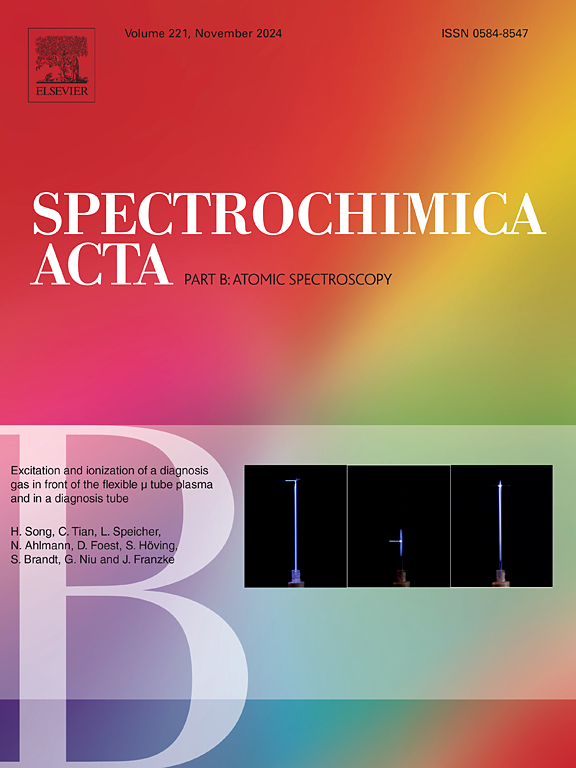用XRF和原子吸收光谱法研究煤飞灰和底灰的理化性质和浸出行为:多变量分析
IF 3.8
2区 化学
Q1 SPECTROSCOPY
引用次数: 0
摘要
从旁遮普的不同行业收集了三份飞灰和底灰样本,并对其进行了分析,以确定其物理属性和重金属含量,以及钠、钾、钙、铝、镁、硫和氯化物的含量。多种试剂的原子吸收光谱分析结果表明,粉煤灰和底灰样品中含量最高的元素是Zn (22.597 ~ 385.0 ppm),其次是Cr (0.5 ~ 100.8 ppm)、Ni (1.1 ~ 87.3 ppm)和Cu (2.0 ~ 23.5 ppm),微量元素为Cd和Pb,其中Cd (0.6 ~ 1.2 ppm)和Pb (2.3 ~ 4.2 ppm)。Na和K的含量都很低,即2 ppm,但在一个粉煤灰样品中Na的浓度达到2.25 ppm。所有样品的水分含量都相当高,超过34%。二氧化硅和氧化铝的含量很高。XRF分析确定了CaO, MgO, Fe2O3, SO3和氯化物的允许范围。然而,样品F含有最多的SiO₂、Fe₂O₃、MgO和Al₂O₃。还研究了浸出剂对金属浸出量的影响,结果表明,没有特定的浸出模式,大多数金属在酸性而不是碱性介质中浸出。为了解释整个重金属测试过程中的数据波动,还使用了统计技术,如PCA、概率图、热图和使用Wards方法的聚类相关。为减轻对健康的潜在危害,在填土、弃置或日后使用前,应先用王水滤除重金属。本文章由计算机程序翻译,如有差异,请以英文原文为准。

Investigation of physicochemical properties and leaching behavior of coal fly ash and bottom ash by using XRF and AAS: Multivariate analysis
Fly ash and bottom ash samples, three each, were collected from different industries of Punjab and analyzed to determine the physical attributes and heavy metals contents along with sodium, potassium, calcium, aluminum, magnesium, sulfur and chloride. Using multiple reagents, the AAS results indicate that Zn (22.597–385.0 ppm) is the most abundant element in both fly ash and bottom ash samples, followed by Cr (0.5–100.8 ppm), Ni (1.1–87.3 ppm), and Cu (2.0–23.5 ppm) while Cd and Pb are present in trace amounts, with Cd (0.6–1.2 ppm) and Pb (2.3–4.2 ppm) detected in any of the samples. Both Na and K are present in very low amounts i.e. <2 ppm except in one sample of fly ash the concentration of Na reaches 2.25 ppm. Moisture content in all the samples is considerably high exceeding 34 %. Silica and alumina are found in significant amounts. XRF analysis confirmed permissible range of CaO, MgO, Fe2O3, SO3, and chloride. However, sample F had the greatest quantities of SiO₂, Fe₂O₃, MgO, and Al₂O₃. The impact of the leaching agent on the quantity of metal that leaches was also examined, and the findings indicate that there is no specific pattern to leaching, most metals leach in acidic rather than basic media. To explain data fluctuation throughout the heavy metal testing procedure, statistical techniques such PCA, probability plots, heatmap and cluster correlation using Wards method were also used. To mitigate potential health hazards, heavy metals should be leached off with aqua-regia before land filling, disposal, or future use.
求助全文
通过发布文献求助,成功后即可免费获取论文全文。
去求助
来源期刊
CiteScore
6.10
自引率
12.10%
发文量
173
审稿时长
81 days
期刊介绍:
Spectrochimica Acta Part B: Atomic Spectroscopy, is intended for the rapid publication of both original work and reviews in the following fields:
Atomic Emission (AES), Atomic Absorption (AAS) and Atomic Fluorescence (AFS) spectroscopy;
Mass Spectrometry (MS) for inorganic analysis covering Spark Source (SS-MS), Inductively Coupled Plasma (ICP-MS), Glow Discharge (GD-MS), and Secondary Ion Mass Spectrometry (SIMS).
Laser induced atomic spectroscopy for inorganic analysis, including non-linear optical laser spectroscopy, covering Laser Enhanced Ionization (LEI), Laser Induced Fluorescence (LIF), Resonance Ionization Spectroscopy (RIS) and Resonance Ionization Mass Spectrometry (RIMS); Laser Induced Breakdown Spectroscopy (LIBS); Cavity Ringdown Spectroscopy (CRDS), Laser Ablation Inductively Coupled Plasma Atomic Emission Spectroscopy (LA-ICP-AES) and Laser Ablation Inductively Coupled Plasma Mass Spectrometry (LA-ICP-MS).
X-ray spectrometry, X-ray Optics and Microanalysis, including X-ray fluorescence spectrometry (XRF) and related techniques, in particular Total-reflection X-ray Fluorescence Spectrometry (TXRF), and Synchrotron Radiation-excited Total reflection XRF (SR-TXRF).
Manuscripts dealing with (i) fundamentals, (ii) methodology development, (iii)instrumentation, and (iv) applications, can be submitted for publication.

 求助内容:
求助内容: 应助结果提醒方式:
应助结果提醒方式:


